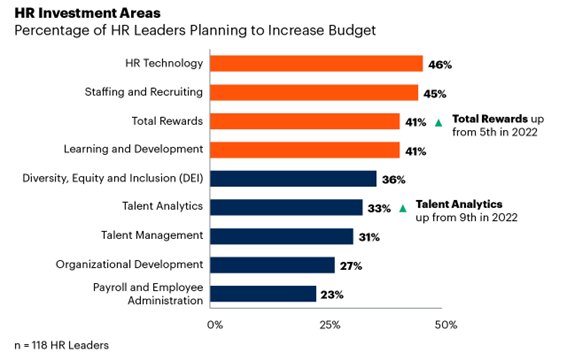An October 2022 Gartner survey of 118 HR leaders revealed the other top investment areas for HR leaders in 2023 are: staffing and recruiting, total rewards and learning and development (see Figure 1).

“HR leaders continue to face persistent high inflation, intense competition for talent and global supply constraints,” said Seyda Berger-Böcker, director of the Gartner HR practice. “Instead of opting for simple cost-cutting measures, leading organisations are focusing on growth and determining which investments will drive competitive advantage in the year ahead.”
To optimise costs and drive growth, HR leaders should act on the below investment imperatives:
HR technology
Technology was ranked as the leading HR investment priority for the second year in a row as HR leaders expect technology-related initiatives to hold the biggest HR function efficiency potential.
Specifically, HR technology can trigger cost savings in HR administration, which has seen a drastic uptick in cost due to pandemic-related tasks such as vaccine mandates, remote work arrangements and contact tracing programs.

According to Berger-Böcker, Gartner research shows yearly spending on HR administration increased from $155 per employee in 2021 to $194 per employee in 2022.
“This is alarming considering HR functions have been trying to reduce the burden of administrative tasks through the use of technology.”
Seyda Berger-Böcker
HR leaders can create efficiencies by implementing human-centric technology solutions – such as skills management or learning experience platforms –to maximise employee experience, retention, collaboration and performance outcomes.
Staffing and recruiting
Organisations continue to face talent shortages as competition expands due to accelerated digitalisation and the adoption of remote work. HR leaders are now tasked with redefining hiring needs to access larger pools of talent and meet hiring demands.
Leading organisations are preparing for extremes in hiring by investing in recruiting technology. To date, digitalisation has pushed organisations to better automate parts of the hiring process; HR leaders are now focusing their investments in all areas of the candidate pipeline, including candidate attraction, sourcing and experience, as well as talent analytics to navigate today’s complex labour market.
Gartner predicts technologies with the most potential to aid recruiting operational excellence are AI-enabled sourcing and screening capabilities and candidate relationship management platforms.
Total rewards
As organisations struggle with cost constraints, HR functions face the challenging task of providing additional financial support to employees affected by today’s cost of living increase, while avoiding a wage-price spiral. This is significant for HR leaders with respondents citing total rewards as the third-largest investment area for 2023 – moving up from fifth in 2022.
HR functions are boosting total rewards investments by focusing on equitable reward and recognition programs, pay transparency and well-being programs. This includes investments in areas such as compensation planning technologies, pay equity tools or smart wearable technology to monitor employee stress and fitness levels.

“HR leaders must recognise that obligations, stressors and concerns from employees’ personal lives will reverberate in their working lives, potentially affecting performance and productivity,” said Hanne Nieberg, director in the Gartner HR practice.
“Total rewards strategies must holistically support employees as people – not just as workers – which includes physical and mental well-being.”
Hanne Nieberg
Learning and development
Skills needs continue to change rapidly, requiring the learning and development (L&D) function to take on an expanded role in supporting employees’ expectations for a more human-centric employee experience.
However, L&D offerings are not keeping up with the pace of change. Gartner research shows less than half (45%) of employees agree the learning their organisation provides is relevant to them.
To deliver on employee expectations, HR leaders must shift their L&D investments towards whole career growth; rather than focusing solely on current or future roles, think more broadly about the growth that helps employees develop as people.
Increased digital learning solutions and changing learning preferences provide an opportunity for L&D functions to invest more heavily in HR technologies that enhance: skills management solutions, learning experience platforms with AI-enabled self-service learning options, coaching applications and virtual reality technologies.
“It’s about intentionally exploring where, how and when employees learn, as well as what impacts their ability to learn effectively,” said Nieberg.





